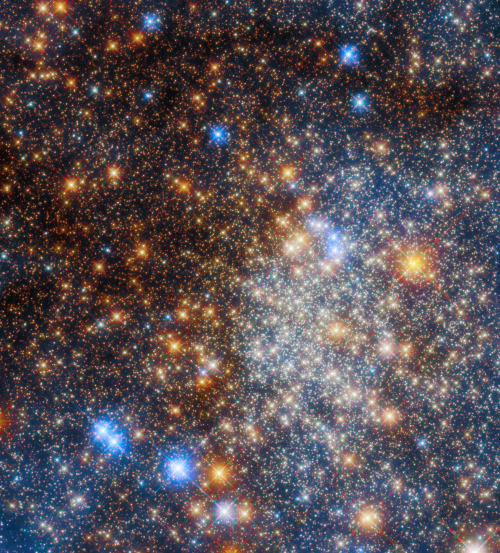The Black Eye Galaxy. Image Credit: Shane Johnson | Jamie Kern | BSU Observatory.

The Black Eye Galaxy. Image Credit: Shane Johnson | Jamie Kern | BSU Observatory.
Imaged in luminance and photometric R, V and B filters. Total exposure time ~25 minutes.
The Black Eye Galaxy (M64) is a relatively nearby spiral with an extraordinary amount of dark dust partially obscuring its nucleus. Red hues peeking out in these dust lanes are caused by reddening when the dust scatters the bluer light from stars embedded within it. The color difference between the center and spiral arms is due to an average age difference between the stars in these locations--blue stars have short lives, so as the star population ages the overall color appears more red.
More Posts from Bsuobservatory and Others

Make your Halloween pumpkin shine bright like a star observed by the James Webb Space Telescope! 🎃
The 8-point diffraction spikes are a signature look in Webb’s images of bright objects in the universe. Download the stencil or any of the other Webb patterns: https://webbtelescope.pub/46HNvPV

Pumpkin space latte, anyone? ☕
Hubble captured this festive array of stars, Terzan 12, found in the Milky Way about 15,000 light-years from Earth. The stars in this cluster are bound together by gravity in a sphere-like shape and are shrouded in gas and dust. As the starlight travels through that gas and dust to Earth, blue light scatters, leaving the redder wavelengths to come through.
Download the full-resolution image here.
Make sure to follow us on Tumblr for your regular dose of space!
A reminder that our public Spring events start this week!

Public nights are here!
July 2024 Public Nights
The observatory will be open to the public, weather allowing, on Wednesdays July 24 and 31 from 9:00 pm - 10:00 pm. Please check back the afternoon of the event for our weather decision!
3/26: Public night is cancelled tonight due to clouds. We'll try again next week.

Uranus and some of its moons on October 20, 2023 // Louis Fico
I think the moons in this image could be Titania, Umbriel, Ariel, and Oberon, tho which points of light they are is hard to say

Messier-20 is called the “Trifid Nebula” because of the three bright lobes in the lower purple-coloured area. This purple region is emitting light, while the upper blue area is just reflecting it.
It is a local star-forming region in our Milky Way galaxy (4,000 light years away). (at Bordeaux, France) https://www.instagram.com/p/B1bxBljC5H9/?igshid=1g0i6zddk37k

2023 October 10
Hidden Orion from Webb Image Credit & License: NASA, ESA, CSA, JWST; Processing: M. McCaughrean & S. Pearson
Explanation: The Great Nebula in Orion has hidden stars. To the unaided eye in visible light, it appears as a small fuzzy patch in the constellation of Orion. But this image was taken by the Webb Space Telescope in a representative-color composite of red and very near infrared light. It confirms with impressive detail that the Orion Nebula is a busy neighborhood of young stars, hot gas, and dark dust. The rollover image shows the same image in representative colors further into the near infrared. The power behind much of the Orion Nebula (M42) is the Trapezium - a cluster of bright stars near the nebula’s center. The diffuse and filamentary glow surrounding the bright stars is mostly heated interstellar dust. Detailed inspection of these images shows an unexpectedly large number of Jupiter-Mass Binary Objects (JuMBOs), pairs of Jupiter-mass objects which might give a clue to how stars are forming. The whole Orion Nebula cloud complex, which includes the Horsehead Nebula, will slowly disperse over the next few million years.
∞ Source: apod.nasa.gov/apod/ap231010.html
We had an error on here earlier - fixed now.

Public nights are here!

STEM Education, Astrophysics Research, Astrophotography, and Outreach located at 24 Park Ave., Bridgewater MA. You'll find us on the two outdoor balconies on the 5th floor, and you'll find our official website here: https://www.bridgew.edu/center/case/observatory .
150 posts
